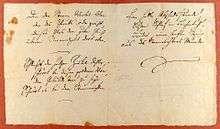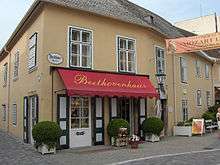Ode to Joy

"Ode to Joy" (German: "An die Freude" [an diː ˈfʁɔʏdə], first line: "Freude, schöner Götterfunken") is an ode written in the summer of 1785 by German poet, playwright, and historian Friedrich Schiller and published the following year in Thalia. A slightly revised version appeared in 1808, changing two lines of the first and omitting the last stanza.
"Ode to Joy" is best known for its use by Ludwig van Beethoven in the final movement of his Ninth Symphony, which does not set the entire poem and reorders some sections (Beethoven's text is given in that article). Beethoven's tune[1] (but not Schiller's words) was adopted as the Anthem of Europe by the Council of Europe in 1972, and subsequently the European Union.
The poem
Friedrich Schiller later made some revisions to the poem when it was republished in 1808,[2] and it was this latter version that forms the basis for Beethoven's famous setting. Despite the lasting popularity of the ode, Schiller himself regarded it as a failure later in his life, going so far as calling it "detached from reality" and "of value maybe for us two, but not for the world, nor for the art of poetry" in an 1800 letter to his long-time friend and patron Christian Gottfried Körner (whose friendship had originally inspired him to write the ode).[3]
The prominent experts Hans-Jürgen Schings,[4] Wolfgang Riedel [5] and Peter-André Alt[6] accentuate the influence of the pietistic theologian Friedrich Christoph Oetinger upon Schiller's philosophy of love. Reinhard Breymayer has newly detected that Oetinger's former vicar Philipp Matthäus Hahn too had such influence upon Schiller and, moreover, a connection to the family of Maria Wilhelmine Countess von Thun und Hohenstein, remembered as the sponsor of a Vienna musically and intellectually outstanding salon and for her patronage of music, notably that of Mozart and Beethoven. Her husband, Franz Josef Count von Thun und Hohenstein, father-in-law of Mozart and Beethoven's patron Karl Alois, Prince Lichnowsky, ordered an astronomic machine constructed by Hahn and produced by Philipp Gottfried Schaudt, head teacher in Onstmettingen near Hechingen. Josef Friedrich Wilhelm, Prince von Hohenzollern-Hechingen, an uncle of count Thun-Hohenstein, had ordered too such an astronomic machine. According to Breymayer's statement, Schiller's poem and particularly the verses "Brüder - überm Sternenzelt/ muß ein lieber Vater wohnen" ("Brothers, above the starry canopy/ There must dwell a loving Father"), are a reference to Hahn's kernel concept of The Fatherly Love of God.[7]
Lyrics
| "An die Freude" | "Ode to Joy" |
|---|---|
Freude, schöner Götterfunken, |
Joy, beautiful spark of divinity, |
Revisions
The lines marked with * have been revised as follows:
| Original | Revised | Translation of original | Translation of revision | Comment |
|---|---|---|---|---|
| was der Mode Schwerd geteilt | Was die Mode streng geteilt | what the sword of custom divided | What custom strictly divided | The original meaning of Mode was "custom, contemporary taste".[8] |
| Bettler werden Fürstenbrüder | Alle Menschen werden Brüder | beggars become brothers of lords | All people become brothers |
Ode to Freedom
Academic speculation remains as to whether Schiller originally wrote an Ode to Freedom (Ode an die Freiheit) and changed it to an Ode to Joy.[9][10] ". . . [T]he thought lies near that it was the early form of the poem, when it was still an 'Ode to Freedom' (not 'to Joy'), which first aroused enthusiastic admiration for it in Beethoven's mind".[11]
Beethoven's musical setting

The ode is best known for its musical setting by Ludwig van Beethoven in the final movement of his Ninth Symphony (completed in 1824), a choral symphony for orchestra, four solo voices and choir.
Uses as a theme song
The basic melody was adopted for the hymn "Joyful, Joyful We Adore Thee" (aka "The Hymn of Joy") by Henry van Dyke, as well as for the songs "A Song of Joy" by Miguel Ríos, and "Road to Joy" by Bright Eyes. The Beethoven setting was adopted as the Anthem of Europe by the Council of Europe in 1972 and the then European Community—since 1993 the European Union—in 1985; the tune was also used for the national anthem of Rhodesia. It has been used in a number of other contexts: notably in The Beatles second film, HELP!, Stanley Kubrick's 1971 film A Clockwork Orange and in the Die Hard film franchise, as well as the anime series Neon Genesis Evangelion and the film, Evangelion: 3.0 You Can (Not) Redo. In 1996, it became the theme song for Triple H in the World Wrestling Federation until early 1998. A version of the song was used as the Everybody Loves Raymond theme song. Recently, it is also used in the game Peggle. An instrumental version of this song is used as theme of the UEFA EURO 2016 Qualifiers and 2018 FIFA World Cup European Qualifiers matches, branded as "European Qualifiers",[12] and since 2005 it is the Copa Libertadores official anthem.[13] It is also used as a closing theme for both the Summer Olympics and Winter Olympics television broadcasts on many networks. Classical radio station KUSC uses it as the official sign off for their pledge drive fundraising.
In popular culture
Over the years, Beethoven's "Ode to Joy" has remained a protest anthem and a celebration of music. From demonstrators in Chile singing during demonstration against the Pinochet dictatorship, Chinese student broadcast at Tiananmen Square, the concert conducted by Leonard Bernstein after the fall of the Berlin Wall and Daiku (Big Ninth) concerts in Japan every December and one after the 2011 tsunami.[14] It has recently inspired flashmob performances at public spaces by musicians in many countries worldwide, including Choir Without Borders's 2009 performance at a train station[15] in Leipzig, Germany, to mark the 20th and 25th anniversary of the Fall of the Berlin Wall, Hong Kong Festival Orchestra's 2013 performance at a Hong Kong mall, and performance in Sabadell, Spain.[16] A 2013 documentary, Following the Ninth, directed by Kerry Candaele, follows its continuing popularity.[14][17]
Other musical settings
Other musical settings of the poem include:
- Christian Gottfried Körner (1786)
- Carl Friedrich Zelter (1792), for choir and accompaniment, later rewritten for different instrumentations.
- Johann Friedrich Reichardt (1796)
- Ludwig-Wilhelm Tepper de Ferguson (1796)
- Johann Friedrich Hugo von Dalberg (1799)
- Johann Rudolf Zumsteeg (1803)
- Franz Schubert's song "An die Freude", D 189, for voice, unison choir and piano. Composed in May 1815, Schubert's setting was first published in 1829 as Op. post. 111 No. 1. The 19th century Gesamt-Ausgabe included it as a lied in Series XX, Volume 2 (No. 66). The New Schubert Edition groups it with the part songs in Series III (Volume 3).[18]
- Pyotr Ilyich Tchaikovsky (1865), for solo singers, choir and orchestra in a Russian translation
- Pietro Mascagni cantata "Alla gioia" (1882), Italian text by Andrea Maffei
- "Seid umschlungen, Millionen!" (1892), waltz by Johann Strauss II
- Z. Randall Stroope (2002), for choir and four-hand piano
- Joyful, Joyful, we adore thee – English version of this song[19]
- Victoria Poleva (2009), for soprano, mixed choir and symphony orchestra
References
- ↑ The usual name of the Hymn tune is "Hymn to Joy" "Hymnary – Hymn to Joy". Retrieved 11 October 2013.
- ↑
 German Wikisource has original text related to this article: Ode an die Freude; Commons:Category:Schiller - An die Freude (1808)
German Wikisource has original text related to this article: Ode an die Freude; Commons:Category:Schiller - An die Freude (1808) - ↑ The German text can be found at http://www.wissen-im-netz.info/literatur/schiller/briefe/koerner/1800/571.htm
- ↑ Cf. Hans-Jürgen Schings: Philosophie der Liebe [Philosophy of love] und Tragödie des Universalhasses. Die Räuber im Kontext von Schillers Jugendphilosophie [Schiller’s youth philosophy] (I). In: Jahrbuch des Wiener Goethe-Vereins, vol. 84/85 (1980/1981), pp. 71–95, here especially pp. 80 f. to Oetinger (ib., note 45, to Breymayer's research).
- ↑ Cf. Wolfgang Riedel: Die Anthropologie des jungen Schiller. Zur Ideengeschichte der medizinischen Schriften und der 'Philosophischen Briefe'. Würzburg 1985; esp. pp. 182–198: "Liebe gleich Schwerkraft. Bausteine zu einer Metapherngeschichte", pp. 198–203: "Theosophie", here esp. pp. 200 f. with note 242 to Oetinger and Detlev Clüver. Riedel mentions often Oetinger.
- ↑ Cf. Peter-André Alt: Schiller. Leben – Werk – Zeit. München 2009, vol. 1. 1759–1791), passim. Cf. especially vol. 1, p. 56 with note 54 on p. 676: "Karl Friedrich Harttmann, der ... in enge Verbindung mit Oetinger trat, trug seit 1774 im Rahmen des von ihm versehenen Religionsunterrichts Prinzipien der pietistischen Lehre an der herzoglichen Akademie vor. Daß sie Spuren auch beim jungen Schiller hinterließ, demonstriert seine Liebesphilosophie [philosophy of love]."
- ↑ Cf. Reinhard Breymayer: Erhard Weigels Schüler Detlev Clüver und sein Einfluss auf Friedrich Christoph Oetinger (1702–1782) [...]. In: Katharina Habermann, Klaus-Dieter Herbst (Ed.): Erhard Weigel (1625–1699) und seine Schüler. Universitätsverlag Göttingen, Göttingen 2016, pp. 269–323, esp. 315-323 to Hahn and Schiller's Ode.
- ↑ Duden, vol. 7, Das Herkuntswörterbuch. Mannheim: Bibliographisches Institut. 1963. p. 446. ISBN 3-411-00907-1. The word was derived via French from ultimately Latin wikt:modus. Duden cites as first meanings "Brauch, Sitte, Tages-, Zeitgeschmack". The primary modern meaning has shifted more towards "fashion".
- ↑ W. Kubacki, "Das Werk Juliusz Slowackis und seine Bedeutung für die polnische Literatur", Zeitschrift für Slawistik, Volume 5, Issue 1 (Jan 1960)
- ↑ Das "Alle Menschen werden Brüder", das Schiller in seiner Ode an die Freude (eigentlich Ode an die Freiheit) formuliert,... - Alexander Görlach, "Der Glaube an die Freiheit", Debatte, 04.08.2010
- ↑ Thayer, A. W.(1817-97), rev and ed. Elliot Forbes. Thayer's Life of Beethoven. (2 vols. 1967,1991) Princeton: Princeton University Press. p. 895.
- ↑ UEFA European Qualifiers TV Intro
- ↑ "Intro Copa Santander Libertadores 2010". CONMEBOL. April 26, 2010. Retrieved June 5, 2010.
- 1 2 Daniel M. Gold (October 31, 2013). "The Ode Heard Round the World: Following the Ninth Explores Beethoven's Legacy". The New York Times. Retrieved 28 Sep 2014.
- ↑ "Video of flash mob – Ode to Joy sung at Leipzig train station (8 November 2009)". You Tube. Dosenlicht. Retrieved 17 December 2015.
- ↑ Megan Garber (9 July 2012). "Ode to Joy: 50 String Instruments That Will Melt Your Heart". The Atlantic. Retrieved 2014-09-28.
- ↑ "Beethoven's Flash Mobs". Bill Moyers. November 14, 2013.
- ↑ Otto Erich Deutsch et al. Schubert Thematic Catalogue, German edition 1978 (Bärenreiter), pp. 128–129
- ↑ "Ode to Joy – sung at Royal Albert hall (London)". British Christian Music Programme. Retrieved 11 October 2013.
External links
 Works related to Ode to Joy at Wikisource
Works related to Ode to Joy at Wikisource German Wikisource has original text related to this article: An die Freude (Schiller) (1786)
German Wikisource has original text related to this article: An die Freude (Schiller) (1786) German Wikisource has original text related to this article: An die Freude (Beethoven)
German Wikisource has original text related to this article: An die Freude (Beethoven) Media related to Ode an die Freude at Wikimedia Commons
Media related to Ode an die Freude at Wikimedia Commons- An die Freude text and translations at The LiederNet Archive
- German and English text, Schiller Institute